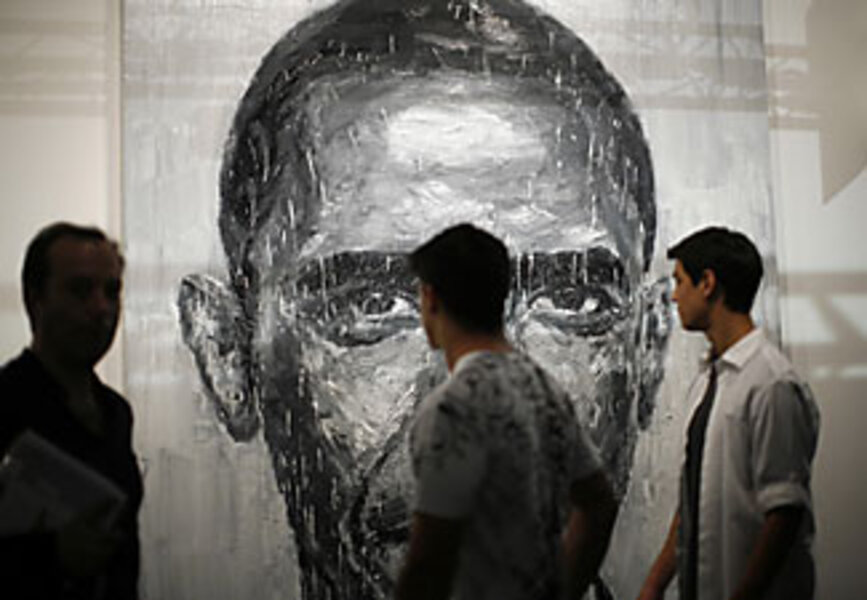Obama's call to arts
| Los Angeles
While the Obama transition team works on headline issues such as the economy and the conflicts in Iraq and Afghanistan, a small but cautiously hopeful cadre of arts groups, arts educators, and artists from Los Angeles to Philadelphia and beyond is nursing the quiet hope that creativity will find its place beside the sterner faces of war and recession on the Jan. 20 White House to-do list.
The incoming president himself has steadily fed such hopes. Barack Obama enters office with the first-ever presidential arts platform drafted during the campaign. While it lists eight strategies, including increased funds for the National Endowment for the Arts (NEA), the three top priorities are:
•Expanding public/private partnerships between schools and arts organizations
•Creating an Artists Corps
•Publicly championing the importance of arts education
"The mere existence of a cultural policy platform is an amazing thing, a good thing," says Richard Kessler, executive director of The Center for Arts Education of New York City. "Nothing like it existed before in the history of our country."
The new president's commitment to the arts comes partially from his own experience. "When I was a kid," he told a crowd in Wallingford, Pa., on April 2, "you always had an art teacher and a music teacher. Even in the poorest school districts, everyone had access to music and other arts." While this preceded research on such well-known modern concepts as the "Mozart effect" – which details how the study of music enhances mental performance – a certain common sense reigned. "People understood that even though they hadn't done all the scientific research," Mr. Obama added, "children who learn music actually do better in math and kids whose imaginations are sparked by the arts are more engaged in school."
Expect the White House to host a steady stream of artists, including jazz and classical musicians as well as poetry readings.
"Our art, our culture," the president-elect told anchor Tom Brokaw on "Meet the Press," on Dec. 15, "that's the essence of what makes America special, and we want to make as much of that as possible in the White House."
Perhaps nothing has attracted as much interest as the proposed Artists Corps, a national service concept that, much like the Peace Corps, would draft legions of young talent into service across the nation's schools and arts organizations.
"The Arts Corps idea couldn't have come at a better time," says Richard Burrows, director of Arts Education for the Los Angeles Unified School District. Up until the recent economic woes rippling through every community in the United States, including Sacramento's recently announced $41.6 billion state budget deficit, the nation's second largest school district was steadily increasing school arts funding – from $6 million in 1999 to $53 million this past year. Now, says Mr. Burrows, everything is up in the air, including a portion of the $8 million budget for a program that brings arts organizations into the schools, the Arts Community Network Partnership.
Many cash-strapped communities are eyeing the Artists Corps as one new opportunity during the tough times ahead. "We may all have to come up with fresh ideas about how to do the things we want to do," Burrows adds.
Three time zones to the east, the nation's largest community arts educational institution, Settlement Music School, serves 15,000 students on six campuses near Philadelphia and New Jersey. Seven percent of its nearly $9 million budget comes from the public sector, says director Robert Capanna. But the relationship sends a strong message. "It functions like seed money," says Mr. Capanna, "which galvanizes the donor community and sends a message about values and priorities."
As public schools have cut their arts budgets, he says arts groups across the country find the demand for their services to be nearly insatiable. The nation faces grave challenges but "the arts can be part of the solution," he says, adding that creativity and innovation are the key to the nation's future competitiveness.
Arts advocates are quick to point out that support for the arts is sound fiscal policy. Federal tax revenues generated by the activities of the not-for-profit arts sector alone total nearly $12 billion annually, says Robert Lynch, president and CEO of Americans for the Arts. That figure is in addition to the for-profit multibillion dollar entertainment industries which are some of the nation's most important exports, he adds. Mr. Lynch was part of the advisory board that helped draft the initial arts platform during the primaries. Candidate Obama was the only contender who expanded upon the basic outline his working group provided, he says.
"Obama took the idea and built on it, coming up with the idea of the Artists Corps," adds Lynch.
There are many tools to help the arts within a potential stimulus package, points out arts analyst Roland Kushner, assistant professor of business at Muhlenberg College in Allentown, Pa. When the General Services Administration contracts for a new building, for instance, it can allocate money for public art. Funding for arts comes under Congress's discretionary monies, he points out, and while federal support for arts and culture has remained steady at roughly $2 billion over the past decade (this allocation includes the NEA, the National Endowment for the Humanities, and the Corporation for Public Broadcasting), it has shrunk drastically as an overall percentage of the budget, which has grown.
Perhaps the most effective role Obama can play in the immediate future is to mount the bully pulpit and lead by example. "Take Malia and Sasha to the museum," says Mr. Kushner, "or show them having music lessons in the White House."
• To view the platform, go to www.barackobama.com/pdf/issues/additional/Obama_FactSheet_Arts.pdf






